Recent research projects
Building cross-discipline, collaborative partnerships to find research driven, evidence-based solutions to create liveable smart green cities for the future.
We work with academic, government and industry partners to deliver research for social, environmental and economic impact.
Read about our recent projects:
Optimising tree planting success for western Sydney
Project Partner: Australian Institute of Botanical Science
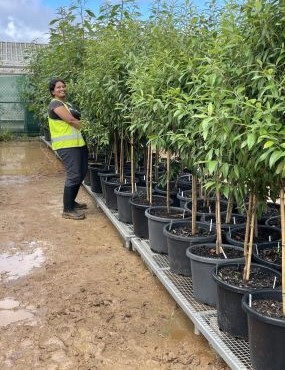 Many urban street tree species face increasingly stressful conditions with a warming and drying climate under climate change.
Many urban street tree species face increasingly stressful conditions with a warming and drying climate under climate change.
This collaborative project aims to test the performance of provenances of a range of species from contrasting climatic regions. We are:
- assessing growth and performance of the provenances
- testing a range of soil amendments aimed to reduce drought stress
The information gained will help ensure the success of future tree plantings in western Sydney.
This project is being conducted in the Australian Botanic Gardens at Mt Annan. Planting began in late 2022.
Assessing use of recycled water for irrigation of urban green spaces
Project Partners: Sydney Water, Botanic Gardens of Sydney
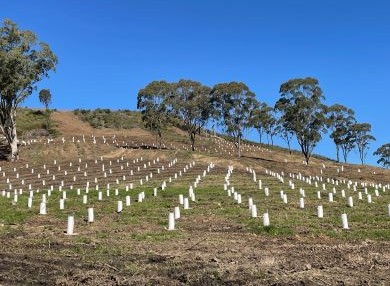 This project is assessing the influence of water quality and soil amendments on plant growth, stress and performance under field conditions. This will help us determine which integrated management techniques provide the best approach and outcome for long term urban plantings in western Sydney.
This project is assessing the influence of water quality and soil amendments on plant growth, stress and performance under field conditions. This will help us determine which integrated management techniques provide the best approach and outcome for long term urban plantings in western Sydney.
The project is being conducted in the Australian Botanic Gardens, Mt Annan.
The field site is fully instrumented with real-time monitoring of soil moisture content and salinity, sap flow of plants, and air temperature and humidity.
- Professor Michelle Leishman
- Dr Laura Fernandez
- Dr Anthony Manea
- Dr David Coleman
- Maria Enfrin (Sydney Water)
- Michael Elgey (Botanic Gardens of Sydney)
Contact: michelle.leishman@mq.edu.au
Internet of Things for Water
Funded by: ARC Industrial Transformation Research Hub
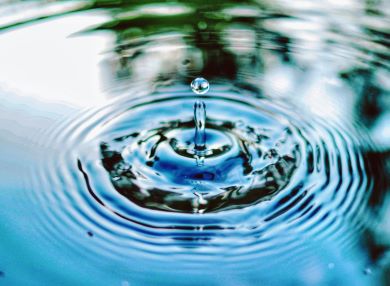 ARC Research Hub in the Internet of Things for Water expects to transform Australian capabilities by delivering cutting-edge technologies, and novel visualisation and analytics methods, supported by new business models.
ARC Research Hub in the Internet of Things for Water expects to transform Australian capabilities by delivering cutting-edge technologies, and novel visualisation and analytics methods, supported by new business models.
The Hub is lead by Queensland University of Technology (QUT), with Macquarie University one of the partner institutions.
The Hub aims to enhance capabilities to secure water for industry, society and the environment, and improve our productivity through new water management techniques.
Breathing green life into industrial landscapes
Project Partners: NSW Government ‘Greening our City’ program, Strathfield Council
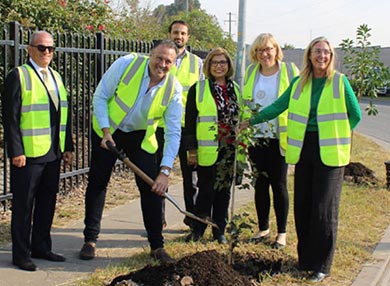 This project sought to identify ways in which trees can improve the health, liveability and workability in harsh urban environments.
This project sought to identify ways in which trees can improve the health, liveability and workability in harsh urban environments.
Smart Green Cities researchers collaborated with Council and local businesses to test and identify tree species that:
- can thrive in harsh urban environments
- improve air quality by trapping and retaining particulate pollution
The project was completed in 2024.
- Dr Anthony Manea
- Damian Gore
- Alessandro Ossola
- Leigh Staas (Sydney Water)
- Yvonne Yunn (Strathfield City Council)
Contact: anthony.manea@mq.edu.au
Tree root intrusion of sewage infrastructure in Greater Sydney
Project Partner: Sydney Water Corporation
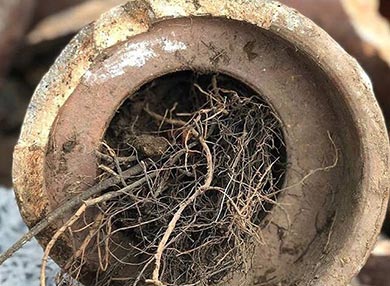 This collaborative project between Smart Green Cities and Sydney Water Corporation created and validated a predictive framework of tree root intrusion risk in sewerage pipes across the Greater Sydney region using:
This collaborative project between Smart Green Cities and Sydney Water Corporation created and validated a predictive framework of tree root intrusion risk in sewerage pipes across the Greater Sydney region using:
- spatial analytics
- plant genomic analysis
- big data and artificial intelligence (AI) models, validated by field data.
New knowledge and techniques developed by the project will lead to a national, and potentially international, evidence-based decision‐making benchmark for water infrastructure management.
Publication: Ossola, A.*, Yu, M., Le Roux, J., Bustamante, H., Uthayakumaran, L., Leishman, M., 2023. Research note: Integrating big data to predict tree root blockages across sewer networks. Landscape and Urban Planning, 240, p.104892.
The project was completed in 2024.
- Professor Michelle Leishman
- Jaco Le Roux
- Alessandro Ossola
- Jessica O'Hare
- Heri Bustamante (Sydney Water Corporation)
- Luther Uthayakumaran (Sydney Water Corporation)
Contact: michelle.leishman@mq.edu.au
Our living river
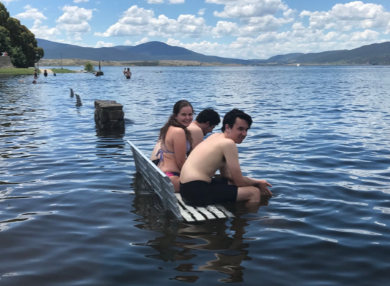 The Parramatta Catchment Group is a collaborative partnership of local and state government, academic and industry organisations working towards the Our living river initiative – making Parramatta River swimmable again by 2025.
The Parramatta Catchment Group is a collaborative partnership of local and state government, academic and industry organisations working towards the Our living river initiative – making Parramatta River swimmable again by 2025.
Healthy waterways are crucial to achieving liveable cities as they ensure the wellbeing of people, flora and fauna.
To do this we need to standardise policies and practices that impact water quality. This project has identified the appropriate policies, planning instruments and sustainable funding mechanisms that will support the goals of the Parramatta River Masterplan.
Smart Green Cities partnered with Civille to release a recommendations paper, Strategic and Statutory Planning Review to Create Our Living River, that sets out recommended planning reforms to:
- achieve clean, clear water
- support and encourage healthy ecosystems in the catchment.
- Peter Davies
- Alex McAuley (Civille)
Contact: peter.davies@mq.edu.au
Living seawalls
Funded by: Sydney Institute of Marine Science (SIMS)
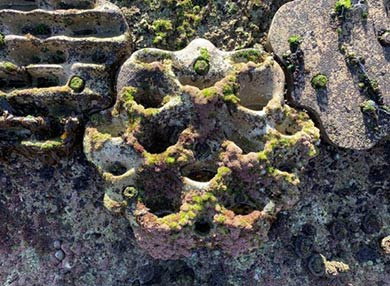 Healthy oceanic ecosystems are critical to combating climate change and its effects on people and cities.
Healthy oceanic ecosystems are critical to combating climate change and its effects on people and cities.
Living Seawalls is an initiative of the Sydney Institute of Marine Science (SIMS) with Smart Green Cities partnering on research to improve the ecological performance of seawalls and other marine built structures, thereby creating healthier oceans.
In partnership with Alex Goad of Reef Design Lab, the research team has developed habitat modules that can be attached to seawalls to increase habitat area and add missing microhabitats, such as rockpools and crevices.
Panels have been installed in several locations around Sydney Harbour. The Barangaroo underwater garden at Waterman’s Cove represents the team’s largest installation to date, with 384 specially designed marine habitat panels.
- Melanie Bishop
- Katie Dafforn
Contact: melanie.bishop@mq.edu.au
SmartCrete CRC
Funded by: the Australian Government
The SmartCrete CRC is a multi-disciplinary partnership led by Macquarie University that will pave the way we create sustainable cities by developing more sustainable environmental concrete, the world’s second most used material after water.
With Australian Government funding of $21 million, the CRC aims to reduce the cost of concrete and improve productivity by facilitating research for the concrete supply chain. It provides contacts, connections and funding for successful research projects to address the various issues and challenges for concrete, especially in its application in infrastructure.
Which Plant Where climate-ready plant selection
Project Partners: Horticulture Innovation Australia, Western Sydney University
Urban greenspace faces increasing 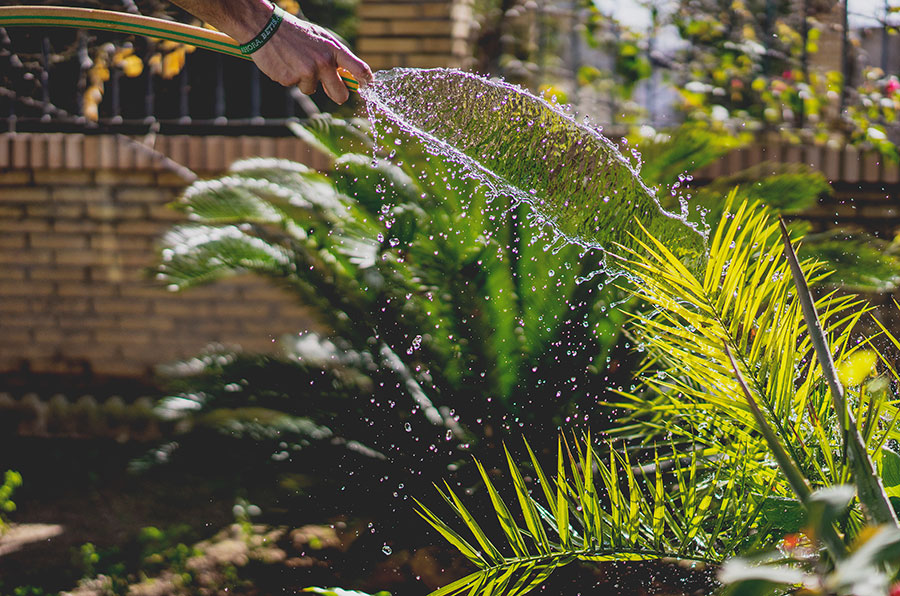 challenges with warming and drying under climate change. The Which Plant Where project aims to increase the resilience of urban greenspace through the development of a world-first climate-smart plant selector tool. The tool supports landscape architects, local councils, plant specifiers and home gardeners to choose ‘the right plant for the right place’, and provides a wide range of resources to support resilient urban greenspace.
challenges with warming and drying under climate change. The Which Plant Where project aims to increase the resilience of urban greenspace through the development of a world-first climate-smart plant selector tool. The tool supports landscape architects, local councils, plant specifiers and home gardeners to choose ‘the right plant for the right place’, and provides a wide range of resources to support resilient urban greenspace.
- Contact: whichplantwhere@mq.edu.au
Towards sustainable development of regional NSW renewable energy zones
Funded by: Macquarie University Research Acceleration Scheme (MQRAS) 2022
This project helps to accelerate the development of novel power stations within renewable energy zones in regional NSW, through design and development of a microgrid in the power and renewable energy lab in Macquarie University.
This research will help identify the optimal size and location of renewable energy generators for new energy hubs in regional NSW, advancing decarbonisation and the sustainable development of the state.
Economically sustainable electric vehicle charging facility
Funded by: Snowy Hydro Ltd
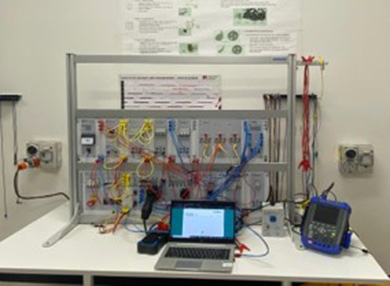 Researchers at Macquarie University wish to:
Researchers at Macquarie University wish to:
- assist the transition towards the zero emissions target
- support the local community in electric vehicle (EV) uptake
- enhance the sustainability and economic benefits of the EV charging facility at Macquarie University.
We are developing innovative charging methods and future installation of EV charging stations, in partnership with Snowy Hydro Ltd. We are undertaking a trial to pursue a stable revenue model and a long term EV adoption achievement.
- Sara Deilami
- Foad Taghizadeh
- Tony Mugan (Snowy Hydro Ltd)
- Carley Beever (Snowy Hydro Ltd)
Contact: sara.deilami@mq.edu.au
Room 206, Level 2, 6 Science Road
Macquarie University NSW 2109